The Snapdragon 855 Performance Preview: Setting the Stage for Flagship Android 2019
by Andrei Frumusanu on January 15, 2019 8:00 AM EST- Posted in
- Mobile
- Qualcomm
- Smartphones
- SoCs
- 7nm
- Snapdragon 855
System Performance - Slightly Underwhelming?
While synthetic steady state workloads are one thing, real-world workloads are more transactional and their performance is determined not just by hardware, but as well by software. Here things like the CPU scheduler and OS APIs can have a big effect on the resulting perceived performance of a device.
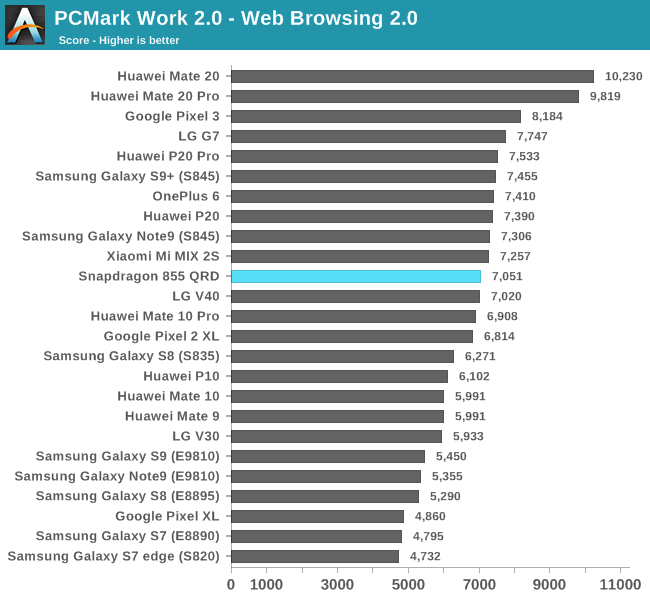
Starting off with PCMark’s Web Browsing 2.0 test, the Snapdragon 855 goes off to a bad start. Here for some reason the S855 QRD wasn’t able to distinguish itself from the lower end of Snapdragon 845 devices – here we had expected the phone to perform and compete similarly to the Kirin 980 in the Mate 20’s.
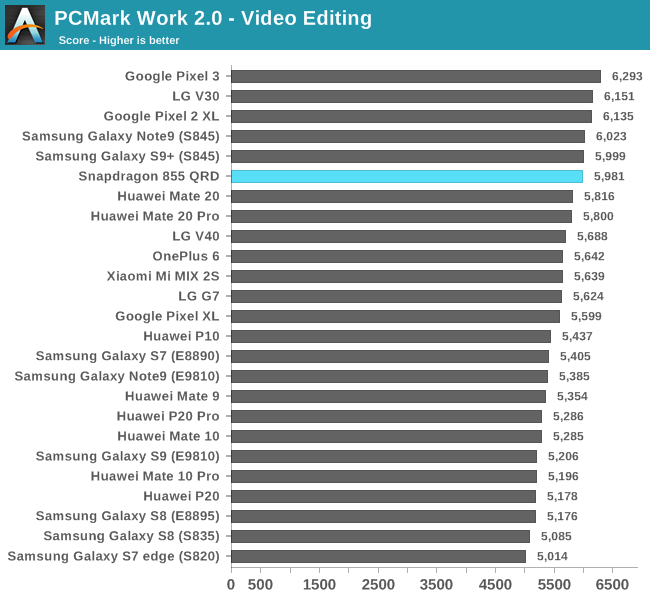
The video editing score is again also quite mediocre, but again the reason for this is that this test has largely reached a performance plateau where most of today’s devices no longer really showcase meaningful differences between each other.
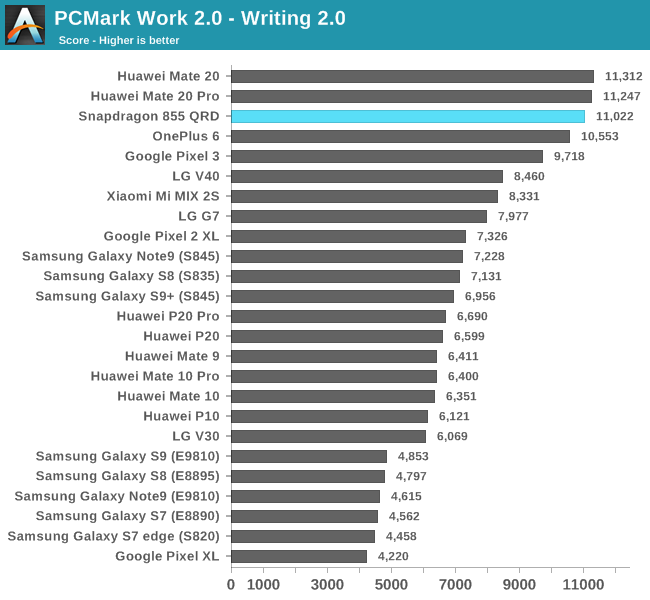
The writing sub-test is among one of the most important in PCMark, and luckily here the Snapdragon 855 QRD performed as expected as it’s within range of the Mate 20’s.
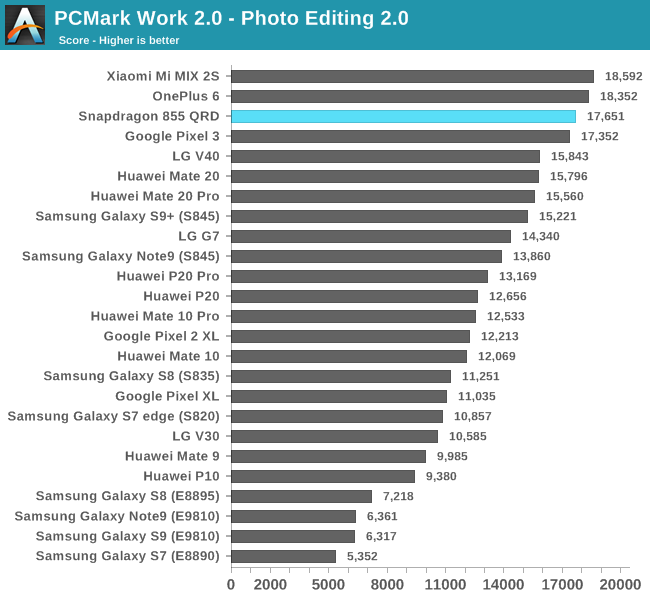
The photo editing sub-test is characterised by shorter heavy RenderScript workload bursts. The QRD performs well, although it’s within the results of the top Snapdragon 845 devices.

Finally in the data manipulation result which is more single-thread bound, we see the Snapdragon 855 perform well, but still remains neck-and-neck with the Kirin 980 devices as well as behind the Pixel 3’s very aggressive scheduler implementation.

Overall, the Snapdragon 855 QRD in PCMark ended up among the top scorers, however I found the result to be a bit disappointing as it doesn’t appear to achieve a higher ranking than the Pixel 3, and Huawei’s Kirin 980 Mate 20’s are also ahead.
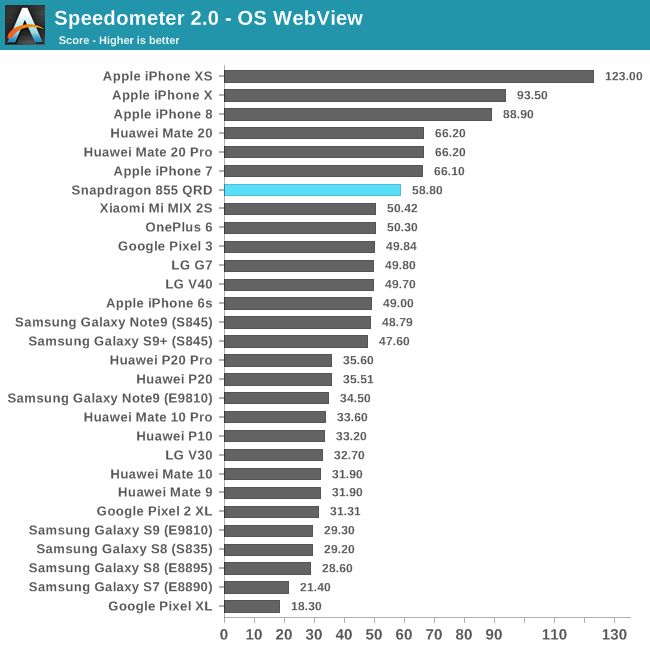
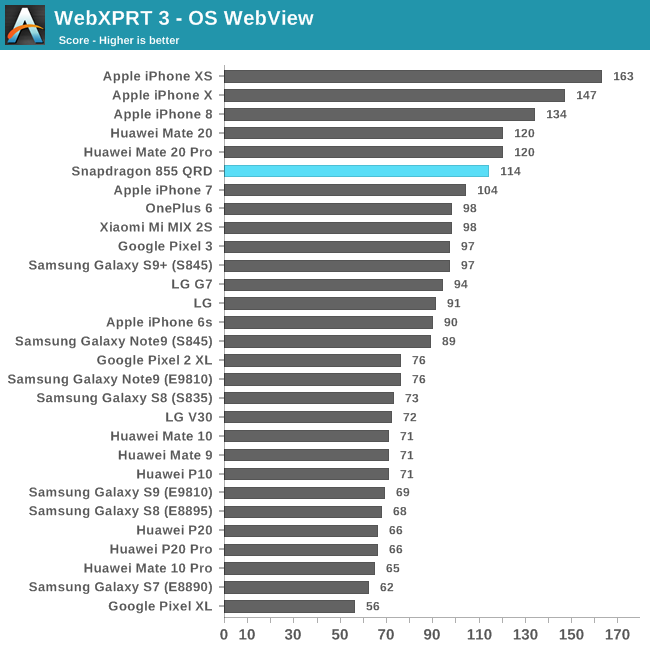
I’ve discussed the results with Qualcomm, and they were surprised to see the numbers end up like this. They stated that it’s something they will look into, and stated that it’s possible that the scheduler and software stack on commercial devices might improve performance. Something to be revisited once we get our hands on the first phones.
The web-based benchmarks such as Speedometer 2.0 and WebXPRT 3 showcase similar relatively muted results. Here I had expected Qualcomm to perform really well given the scheduler performance showcase of the Snapdragon 845. The results of the Snapdragon 855 are quite meagre, especially in a steady-state throughput workload such as Speedometer 2.0. Here the Snapdragon 855 only manages to showcase a ~17% improvement over the last generation, and also lags behind the Kirin 980 by some notable amount.
Performance Scaling Ramp Test
One of the newer kind of tests I introduced last year and has used in our review of the Apple iPhone XS is the scaling ramp test – here showcasing the improved DVFS responsivity of iOS12 across several generations of iPhones.
I’ve quickly ran this on the S855 QRD to be able to get a sense of the scheduler and DVFS mechanism:
Here we see the Snapdragon 855 QRD being able to scale from a sleeping idle workload state to its maximum performance state in around 100ms. To compare this, I also showcase the scaling behaviour of the S845 in both the S9+ as well as the Pixel 3. The difference between the Pixel 3’s aggressive boost behaviour and the S9’s more step-wise frequency scaling showcases the best visual representation of the perceived responsiveness difference between the two devices.
The Snapdragon 855 here falls somewhere in-between both. It’s to be noted that the workload does get boosted to an “efficient” big core at 2.45GHz in around 40ms which is a very fast scaling behaviour.
Comparing the Snapdragon 855 against the Kirin 980, we see that the Snapdragon isn’t any slower in reaching the maximum performance states. What is odd in these results is that the workload sees a significant pause of ~2.4ms when migrating over from the little cores, something that seems to affect only devices with Qualcomm’s custom scheduler. It’s an interesting find that I’ll have to investigate more.
Overall, real-world performance of the Snapdragon 855 is a bit lower than I had expected it to be. I’m not exactly sure what the cause here is; on the scheduler side we’ve verified that the workload doesn’t inherently scale slower than the Kirin 980. The only other explanation I could see is that we might be seeing some disadvantage of the smaller L3 cache or even the higher DRAM latency.
As we’ve seen in past Snapdragon performance previews, final commercial device performance is subject to change, and it’s possible the performance situation will be more tuned in actual shipping phones.


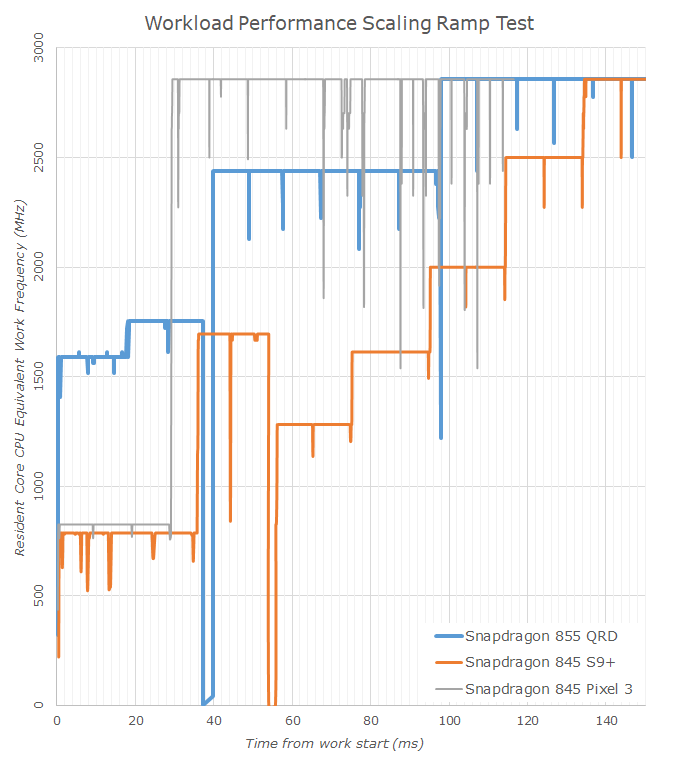
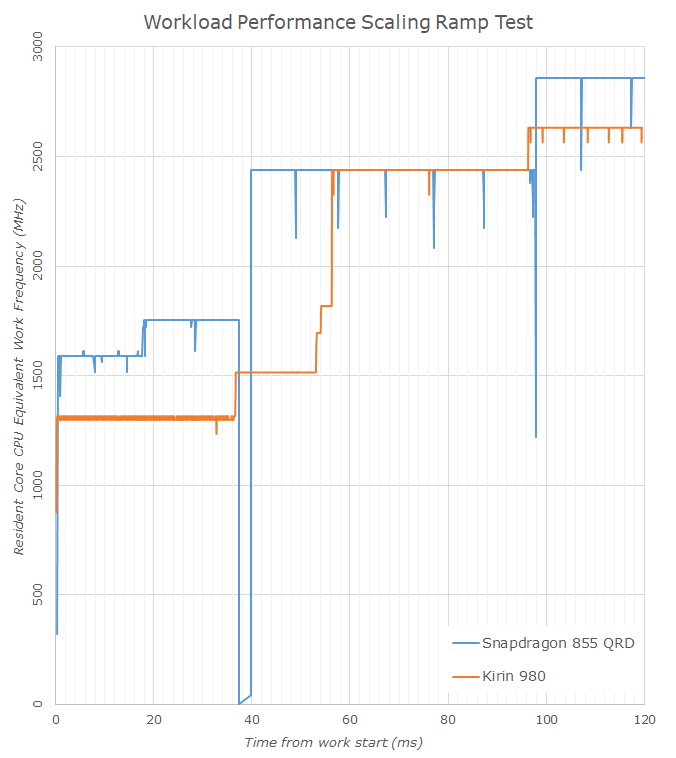








132 Comments
View All Comments
Spunjji - Wednesday, January 16, 2019 - link
Sorry, but that's just not true. I have yet to use a phone that feels consistently faster than the OnePlus 6 I'm currently using as a daily driver, and I've done a whole bunch of messing with custom ROMs / kernels, starting back with Cyanogenmod 6 on a Dell Streak.gijames1225 - Tuesday, January 15, 2019 - link
Sounds very positive given that phones already perform great at the flagship level. The single core improvement is greatly welcomed given how much that matters for javascript.fred666 - Tuesday, January 15, 2019 - link
I like their performance over time graph on page 1.It shows the 855 to be faster than the 845, which is faster than the 835, which is slower than the 820. What? Their performance dropped in that generation?
yeeeeman - Wednesday, January 16, 2019 - link
Yes. In floating point, the SD820 based on their own custom cores (built on an evolution of Krait cores called Kryo) was much better than everything, including next gen SD835 which used an IP from ARM the cortex A72.fred666 - Wednesday, January 16, 2019 - link
so it pretty much means their graph is worthless. Floating point should not be the primary indicator of performance, integers are much more used by most popular use casesSpunjji - Wednesday, January 16, 2019 - link
He didn't say the graph shows FP performance, he just mentioned that 820 was unusually strong in that area. My guess is it's a representation of overall performance based on some or other standard benchmark. That doesn't make it "worthless", because it's literally only there to show a rough comparison between historical chipsets.cpkennit83 - Thursday, January 17, 2019 - link
Actually it was the A73. The A72 is actually stronger in fp but slower in integer workloadsstennan - Tuesday, January 15, 2019 - link
Please do a podcast soon. There has been so much going on with pc Cpu/gpu and now incoming mobile cpu that I miss having the anandtech deep dive!melgross - Tuesday, January 15, 2019 - link
Well, it’s all very interesting, but still the elephant in the room is Apple’s A series, no matter what. Take that out, and the 855 and 980 are excellent chips, but with it in, they are just mediocre.cpkennit83 - Tuesday, January 15, 2019 - link
They are excellent chips no matter what. A12 big cores are twice as large or more than a76 cores.No android Oem is willing to pay a big premium for their flagship socs, so the qualcomms and huaweis of the world don't pressure arm to spend the big $$ needed to fund the development of truly wide cores. The only one who seems interested in going big is Samsung, but they can't get their act together.
Still performance is more than adecuate in the a76 flagship SOCS, and efficiency is slightly better than a12, so for me this generation is the best in the android space since the SD800.